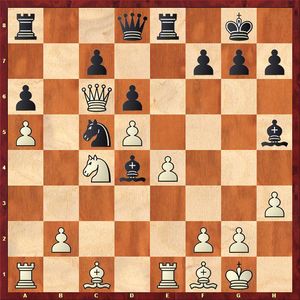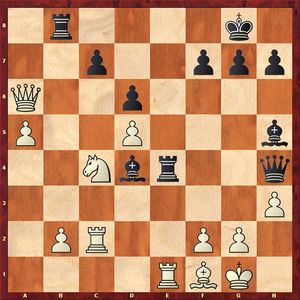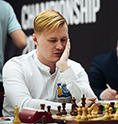14 March 2016
Mayhem at Telegraph
Round one of the Moscow Candidates Tournament in the review of Vladimir Barsky.
While a theater is said to begin with a cloakroom, a chess event begins with finding a suitable "theater". Football players are used to play in football stadiums, hockey players would play in hockey rinks, tennis players (believe it or not!) do so on tennis courts, but chess players somehow feel that chess clubs is other than comme il faut venue for that matter. This is why they are seen performing everywhere: in hotels, theaters, concert and sports halls, department stores, libraries and banks, once at a former candy factory; on one occasion they used to perform even in a glass cube set up in the middle of a busy street, as well as in the Kremlin, the Louvre Museum, the Tretyakov Gallery, and the Russian Museum. The author of these lines had a chance to play chess in a synagogue once - God forgive me my writing these lines on a Saturday day. Telegraph, for one, seems to have never been played within, but now this summit has been conquered after all!
However, in order to get into the Central Telegraph building prior to the start of the Candidates Tournament, we had to sweat out a long queue and comply with the "FSO" (Federal Protective Service) norms in terms passing through a metal detector, showing the contents our bags and switching on our cameras. Since I am used to taking pictures from my camera over to my computer following the end of each working day, having turned on the computer had the effect of its screen displaying a variation on the famous painting by Kazimir Malevich. Upon careful few moments’ study of a black rectangle a security guard then uttered complacently:
–Okay, the camera is on, you may pass!
The metal detector frame opened onto a vast open space equipped with tables and chairs, a row of monitors and a large-diameter central screen. There is a souvenir stall in the middle with T-shirts, lapel badges, magnets and other minor items branded with the Candidates Tournament’s logo. The cheapest item, an excellent plastic lapel badge, will cost its buyer as many as 320 rubles. The back side to the stall abuts on a glass pavilion fitted with leather sofas, which is most likely to be a recreation room for VIP guests (judging by the sofas, because the main hall has plastic chairs only). Security guards and volunteers are everywhere; however, an innocent question: "Where is the press-center after all?" could be answered by neither representative of those two groups. The most obvious place for journalists to work at is the spectators’ room, but the power plugs for computers have not been detected yet. However, an entire tournament is still ahead, leaving us with plenty of time to seek for them!
Joint area of the press center and spectators’ hall
There have gathered by no means less than fifty colleagues equipped with photo and video cameras. "Today’s special" is the first move to be made by President Serzh Sargsyan. In the meantime, the journalists were addressed by the RCF President Andrey Filatov, the tournament director Ilya Merenzon and Zurab Azmaiparashvili, the nameplate of whom labeled him as "FIDE Supervisor". Honestly, I have never before heard of the Georgian grandmaster occupying such a position, so I decided to look it up on the Internet, where it reads that the Russian word supervisor "originates from the English word supervisor, i.e. an overseer or a monitor. Supervisor is the job title of a low level management position that is primarily based on authority over a certain group of workers (such as salespeople, merchandisers, and sales representatives). The position of a supervisor has come to acquire its most widespread application in the field of sales. Job description of a supervisor is very similar to that of a foreman."
Zurab Azmaiparashvili, Andrey Filatov and Ilya Merenzon
The supervisor was inquired his opinion about the World Champion Magnus Carlsen’s proposal on changing the world championship’ format.
“Carlsen, just as any other person in the world, is free to share his point of view via as many interviews as he deems necessary,” said Azmaiparashvili. “Being a member of the FIDE Presidential Board, however, obliges him to submit his proposals in writing in order for FIDE to take these proposals into consideration.”
Andrey Filatov informed about the Russian Chess Federation’s having some initiatives on this important issue as well:
“Both RCF and I personally have had a proposal, which I have duly issued in the writing. It will be announced on the FIDE Presidential Board Meeting. The final decision, adopted upon preliminary discussions, will be announced.”
Roughly half an hour prior to the start of the round the journalists were admitted into the room; we were so many that a decent place near the tape had to be elbowed for. Well, at least it was immediately clear where to head for: I would always look up to our maître Boris Georgievich Dolmatovsky to fall in beside him. We look around to find ourselves surrounded by black walls, black floor, black tables and chairs.
“It is somewhat grim-looking here,” sighs Boris Georgievich, “the participants will probably find it psychologically difficult to stay for the duration of 5-6 hours in this environment...
As for me, I paid attention to all chairs being of equal size, even though Peter Svidler, for one, is slightly taller than Anish Giri. I remember Vladimir Kramnik looking for a bigger-size chair two years ago in Khanty-Mansiysk, which was finally delivered to him by us right out of the Appeal Committee room... The chessmen are of a new agone-type, such as used to be played by Carlsen and Anand back in their 2014 match in Sochi. I wonder whether Vishy is going to enjoy any sort of competitive edge thanks to better familiarity with the "woodware?"
Chess players’ workplace
The first participant to arrive at the scene of action was Sergey Karjakin, followed by other grandmasters taking their seats within a minute or two. Then the hall was entered by Serzh Sargsyan, Kirsan Ilyumzhinov, Andrey Filatov, Alexander Zhukov and Zurab Azmaiparashvili. President of Armenia warmly welcomed Levon Aronian and started discussing something with him in a lively manner. Then he awakened to the presence of Anish Giri, sitting opposite of Levon, and greeted him. In a few minutes the guests of honor approached the occupants of other tables. Surely Mr. Sargsyan wanted to make the first move on behalf of Aronian, but the latter played Black, so Anish Giri had to be assisted instead. Finally, the pawn was triumphantly moved from d2 to d4, all pictures taken, and the game finally began. Interestingly, all four games started off to different openings.
Perhaps only 1.g3 и 1.b3 have been left untested...
Following the start of the round your correspondent continued his tour of the telegraph building. Besides the main room, however, there is some "behind the scenes" territory as well here: a room of live stream operators, some offices, even a field kitchen designed for preparing hot and cold snacks for participants and special guests of honor (there is nothing for ordinary spectators and journalists). There is an interesting detail to add: when one of the participants leaves for the WC room, entrance to the backstage closes so as to prevent grandmaster meeting any foreigners (or not foreigners) within the length of this intersection.
Boris Gelfand and Alexandra Kosteniuk
The gallery on the opposite side of the hall accommodates a room for the English-speaking commentators. The first day the spectators were worked for by Alexandra Kosteniuk and Evgeniy Miroshnichenko, and a journalist from BBC, who, according to the organizers, was supposed to contribute to an outside look onto the world of chess. Boris Gelfand happened to be the broadcast’s guest of the day. The Russian-language commentator Sergey Shipov is seated elsewhere. As the information about the additional program of the Candidates Tournament appeared only on the day of the first round, the action taking place at the "Russian Chess House" near the Belarusskaya metro station remained unaware but to a very few, so that only a limited number of people arrived to follow on the grandmaster in a live mode, whereas following him via Internet was possible to none at all: the official website of the tournament, taking place at the territory of Russia, has neither Russian-language tab no any suitable premises to launch the video stream from.
* * *
Creative works of the Candidate Tournament participants will be subjected to analysis by grandmaster Dmitry Kryakvin in his reviews, whereas as of the moment we present a brief chess content of round one for you to familiarize with.
Peter Svidler has confidently equalized out of the opening as Black - it looks like his opening choice (one of the lines of the Slav Defense) appears to have come as a surprise for Karjakin. At one point it even felt like White was in for hard-time defensive duties, but it was only an illusion, and on move 30th the opponents agreed to a draw.
A decent goalmouth chance was missed by Hikaru Nakamura.
Nakamura – Caruana

For the moment Black is up a pawn, although it is clear to drop soon as the d6-pawn is hanging, thus making the c5-knight vulnerable as well. However, the immediate 21.Nxd6? fails to 21…Nd4 22.Rxc5 Nxf3+, forking. The planned capture can be prepared via 21.Rd1. After 21…Rfd8 22.Nxd6 (22.Bg4!? is interesting as well) Black already gains nothing from 22...Nd4 23.Rxc5 Nxf3+ 24.Kg2 (there is no more any fork), whereas in the case of 22...Nxd6 23.Rxc5 g5 24.hxg5 hxg5 25.Be3 White’s edge is beyond any doubt.
Hikaru, on the other hand, hastened to cash in, allowing one of his bishops be traded off, and Fabiano went on to gradually equalize the game: 21.Bxd6?! Nxd6 22.Nxd6 b6 23.Rb1 Rab8 24.Nc4 Na4 25.Bg4 Rfd8 26.d6 h5 27.Bh3 b5 28.Nxa5 Rxd6 29.Nc6 Rb6 30.Nb4 Nc3 31.Rb3 Draw.
Uneasy defense had to be carried out by Levon Aronian in the Queen's Gambit with 5.Bf4 - this line used to be very popular five years ago during the Candidate matches in Kazan. Anish Giri is famous for his solid opening preparation, which extends all the way to deep endgames, so he managed to have his opponent substantially squeezed. Despite all this Levon still succeeded in getting out of a scrape by defending an unpleasant ending.
A sole victory from the start, just as happened two years ago in Khanty-Mansiysk, was scored by Vishy Anand - again as White and again in the Ruy Lopez Defense. However, this time his opponent was a different player (back then Aronian fell victim to the hands of the Indian magician).
Anand – Topalov

Anand unveiled a new idea in the opening, but Topalov reacted more than properly and overtook initiative. At the press conference Veselin voiced that at the time he was already looking for some decisive continuation, some sort of a blow, but found nothing. For example, after 20...f6 21.Be3 Bxe3 22.Rxe3 Re7 (an unexpected and beautiful idea of trapping the c6-queen) 23.b4 Be8 24.Qxa8 Qxa8 25.bxc5 dxc5 Black can hardly expect to succeed because of his damaged pawn structure.
Kosteniuk wondered if Topalov calculated the consequences of the 20...Bxf2+! shot with the idea of 21.Kxf2 Qh4+ 22.g3 Nxe4+, and the Bulgarian grandmaster admitted that capturing a pawn with the knight escaped him completely. Meanwhile, following 23.Rxe4 Qxe4 24.Ne3 (24.g4 Qe1+ 25.Kg2 Bg6 just looks very grim for White indeed) 24...Qf3+ 25.Kg1 Qxg3+ 26.Ng2 Qxh3 Black ends up with a rook and three pawns versus two White’s minor pieces coupled with the white king being exposed, leaving Anand with difficult defensive duties to take care of.
20…Nb3?! 21.Rb1
According to Topalov he considered this move impossible, while the reasons of it are hard to get at. Let’s suppose that White were to respond with 21.Ra3 – so what? After 21…Nxc1 22.Rxc1 Rb8 23.Rc2 Anand would also be in a good shape.
21...Nxc1?
This is an error, which was unanimously condemned by both grandmasters. Black should have gained back his pawn via 21...Bg6, upon which the chances of both sides would be roughly equal.
22. Rbxc1 Rb8
Otherwise the b-pawn is likely to turn into a formidable force.
23.Qxa6 Qh4 24.Rc2 Rxe4

25.Ne3!
This is an excellent move, destroying coordination of Black’s pieces.
25…Qd8
Nothing is attained by 25...Bxe3 26.Rxe3 Rxe3 27.fxe3 Qe1 in view of 28.Qa7 Re8 29.a6 – White has everything well defended, while his passed pawn is fast to promote.
26.Qc4 Bg6 27.Bd3 Rf4 28.Bxg6 hxg6
An intermediate move 28...Bxe3? belongs to the “harm set, harm get” category: 29.Be4 Bc5 30.Bxh7+, leaving Black down an exchange.
29.g3 Re4 30.a6 Qe8 31.Rce2 Bb6 32.Qd3 Ra8 33.Kg2?!
This is a substantial inaccuracy since White should have first taken care of supporting his passed pawn by 33.b4!
33…Qa4 34.b3 Rd4 35.bxa4
The engine comes up with a witty resource 35.Qc2 Qxa6 36.Nf5!!, for example: 36...Rb4 37.Ne7+ Kf8 38.Nxg6+! with a smashing attack or 36…Rd3 37.Ne7+ Kf8 38.Qc6, and Black has very little to be happy about. Such a resource, however, is hard to uncover even if you have a truckload of time for thinking at your disposal.
35…Rxd3 36.Nc4 Rxa6 37.a5 Bd4?
Black should have immediately seen about eliminating the d5-pawn not because of it being so much in the way of achieving something, but rather to enable the rook to swing into defending his kingside along the 5th rank. Following 37...Bc5 38.Re8+ Kh7 39.R1e7 Rxd5 40.Rxf7 Rf5 the game would have balanced out.
38.Re8+ Kh7 39.R1e7 Rc3 40.Nd2 Rc2 41.Ne4 f6

42.h4!
White launches an attack which can be defended against by no means other than bailing out. The price of bailout is too high, however.
42…Rxa5 43.Rf7 g5 44.h5 Rxf2+ 45.Nxf2 Ra2 46.Rff8 Rxf2+ 47.Kh3 g4+ 48.Kxg4 f5+ 49.Rxf5 Black resigns.






















